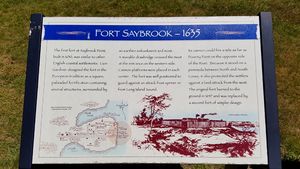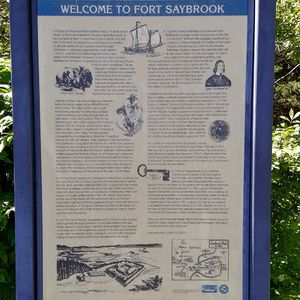Fort Saybrook: Difference between revisions
John Stanton (talk | contribs) No edit summary |
John Stanton (talk | contribs) m Text replace - "width="500"" to "width="-500" height="-500"" |
||
| (8 intermediate revisions by the same user not shown) | |||
| Line 1: | Line 1: | ||
{{SocialNetworks}} | {{SocialNetworks}} | ||
{{PageHeader}} | {{PageHeader}} | ||
'''{{PAGENAME}}''' (1635-1647, 1648-1815) - A English colonial fort established in 1635 by Englishman Lion Gardiner in present day Middlesex County, Connecticut. Said to be one of Connecticut's oldest settlements and first military fort. Named Fort Saybrook after English Viscount Saye and Baron Brook. Burned down in 1647 and rebuilt nearby in 1648. The site was used intermittently until the [[War of 1812]] when it was renamed [[Fort Fenwick]] after Colonel [[George Fenwick]], an early colonist. Abandoned after the war. | '''{{PAGENAME}}''' (1635-1647, 1648-1815) - A English colonial fort established in 1635 by Englishman [[Lion Gardiner]] in present day Middlesex County, Connecticut. Said to be one of Connecticut's oldest settlements and first military fort. Named Fort Saybrook after English Viscount Saye and Baron Brook. Burned down in 1647 and rebuilt nearby in 1648. The site was used intermittently until the [[War of 1812]] when it was renamed [[Fort Fenwick]] after Colonel [[George Fenwick]], an early colonist. Abandoned after the war. | ||
{|{{FWpicframe}} | {|{{FWpicframe}} | ||
| Line 9: | Line 9: | ||
|- | |- | ||
|colspan="2"|[[File:Fort Saybrook 1636.jpg|795px|thumb|center|Fort Saybrook 1636]] | |colspan="2"|[[File:Fort Saybrook 1636.jpg|795px|thumb|center|Fort Saybrook 1636]] | ||
|- | |||
|colspan="2"|[[File:Fort Saybrook Site.jpg|795px|thumb|center|The Modern Representational Fort Saybrook Site.]] | |||
|} | |} | ||
== Fort Saybrook History == | |||
== | [[File:Fort Saybrook Panel.jpg|thumb|left|300px|Fort Saybrook Interpretive Panel.]] | ||
[[File:Fort Saybrook Sign.jpg|thumb|left|300px|Fort Saybrook Sign.]] | |||
In 1635 Lieutenant [[Lion Gardiner]], a Scotsman and accomplished engineer, was engaged under a four year contract by [[John Winthrop Jr]], son of the governor of the Massachusetts Bay Colony, to build and command a fort to protect the colonists. Gardiner supervised the construction of Fort Saybrook near the mouth of the Connecticut River in present day Connecticut, and commanded it while the settlers established farms and settlements. | In 1635 Lieutenant [[Lion Gardiner]], a Scotsman and accomplished engineer, was engaged under a four year contract by [[John Winthrop Jr]], son of the governor of the Massachusetts Bay Colony, to build and command a fort to protect the colonists. Gardiner supervised the construction of Fort Saybrook near the mouth of the Connecticut River in present day Connecticut, and commanded it while the settlers established farms and settlements. | ||
| Line 21: | Line 24: | ||
The fort was refurbished during the [[Revolutionary War]] but never used. During the [[War of 1812]] the fort was partially reconstructed and renamed [[Fort Fenwick]]. After the war the fort was abandoned. | The fort was refurbished during the [[Revolutionary War]] but never used. During the [[War of 1812]] the fort was partially reconstructed and renamed [[Fort Fenwick]]. After the war the fort was abandoned. | ||
{{Clr}} | |||
== Current Status == | == Current Status == | ||
The fort site was razed for a railroad turnhouse in 1871 and all traces of the original fort were destroyed by a 1936 WPA project. Monuments and markers remain. | The fort site was razed for a railroad turnhouse in 1871 and all traces of the original fort were destroyed by a 1936 WPA project. Monuments and markers remain along with a modern representation of the Fort Saybrook Site. | ||
---- | ---- | ||
{| | {| | ||
| | | | ||
<googlemap version="0.9" lat="41. | <googlemap version="0.9" lat="41.286358" lon="-72.35214" zoom="16" width="-500" height="-500" scale="yes" overview="yes" controls="large" icons="http://www.fortwiki.com/mapicons/icon{label}.png"> | ||
(F) 41. | (F) 41.284272, -72.352108, Fort Saybrook | ||
(F) 41.28833, -72.35306, Fort Fenwick | (F) 41.28833, -72.35306, Fort Fenwick | ||
(1812-1815) | (1812-1815) | ||
| Line 49: | Line 53: | ||
* [http://pequotwar.org/archaeology/overview-siege-and-battle-of-saybrook-fort/ Pequot Museum - The Siege and Battle of Saybrook Fort] | * [http://pequotwar.org/archaeology/overview-siege-and-battle-of-saybrook-fort/ Pequot Museum - The Siege and Battle of Saybrook Fort] | ||
* [http://www.saybrookhistory.org/web_page.php?id=13 Old Saybrook Historical Society - Brief History of Old Saybrook] | * [http://www.saybrookhistory.org/web_page.php?id=13 Old Saybrook Historical Society - Brief History of Old Saybrook] | ||
{{Visited| | {{Visited|10 Jun 2016}} | ||
__NOTOC__ | __NOTOC__ | ||
| Line 62: | Line 66: | ||
[[Category:Colonial Forts]] | [[Category:Colonial Forts]] | ||
[[Category:Coastal Forts]] | [[Category:Coastal Forts]] | ||
[[Category:Pequot War Forts]] | |||
[[Category:2016 Research Trip]] | |||
Latest revision as of 18:18, 7 January 2019
|
Fort Saybrook (1635-1647, 1648-1815) - A English colonial fort established in 1635 by Englishman Lion Gardiner in present day Middlesex County, Connecticut. Said to be one of Connecticut's oldest settlements and first military fort. Named Fort Saybrook after English Viscount Saye and Baron Brook. Burned down in 1647 and rebuilt nearby in 1648. The site was used intermittently until the War of 1812 when it was renamed Fort Fenwick after Colonel George Fenwick, an early colonist. Abandoned after the war.
Fort Saybrook History  In 1635 Lieutenant Lion Gardiner, a Scotsman and accomplished engineer, was engaged under a four year contract by John Winthrop Jr, son of the governor of the Massachusetts Bay Colony, to build and command a fort to protect the colonists. Gardiner supervised the construction of Fort Saybrook near the mouth of the Connecticut River in present day Connecticut, and commanded it while the settlers established farms and settlements. A conflict broke out between the local Pequot tribe and the colonists and forced Governor Winthrop to declare war against the Pequot. Fortunately for the colonists the Pequots had also angered another tribe, the Mohegans who joined with the colonists in attacking the Pequot settlement and fort near present day Mystic. The battle resulted in a massacre of the Pequots, some 300 men, women and children were said to have been killed and many captured. The remainder of the Pequots assimilated into other tribes. The Pequot Fort and settlement were burnt to the ground. During the Pequot War Gardiner and the settlers were trapped inside the fort and when they ventured out to get food, some were caught by the Pequot and roasted alive, others were killed outright. Gardiner was wounded himself on several occasions while leading foraging parties. Fort Saybrook caught fire in the winter of 1647, destroying all the buildings inside the palisade. The fort commander and his family barely escaped with their lives. The fort was rebuilt of stone on a site closer to the river and served to protect the community against periodic attacks until they subsided in the early 1700s. The fort was refurbished during the Revolutionary War but never used. During the War of 1812 the fort was partially reconstructed and renamed Fort Fenwick. After the war the fort was abandoned.
Current StatusThe fort site was razed for a railroad turnhouse in 1871 and all traces of the original fort were destroyed by a 1936 WPA project. Monuments and markers remain along with a modern representation of the Fort Saybrook Site.
Sources:
Visited: 10 Jun 2016
| ||||||||

